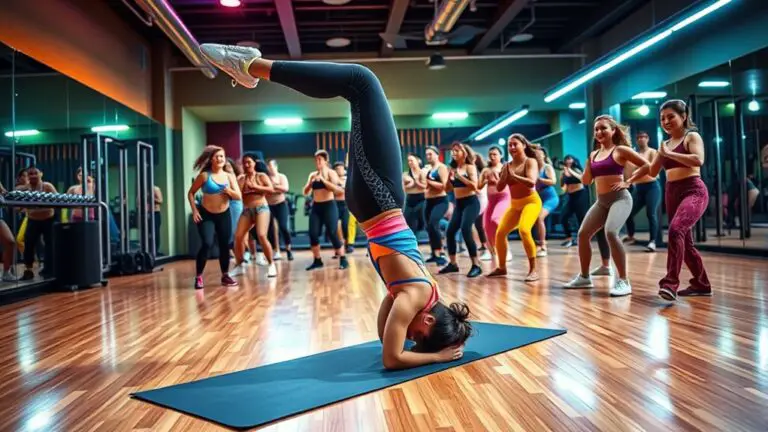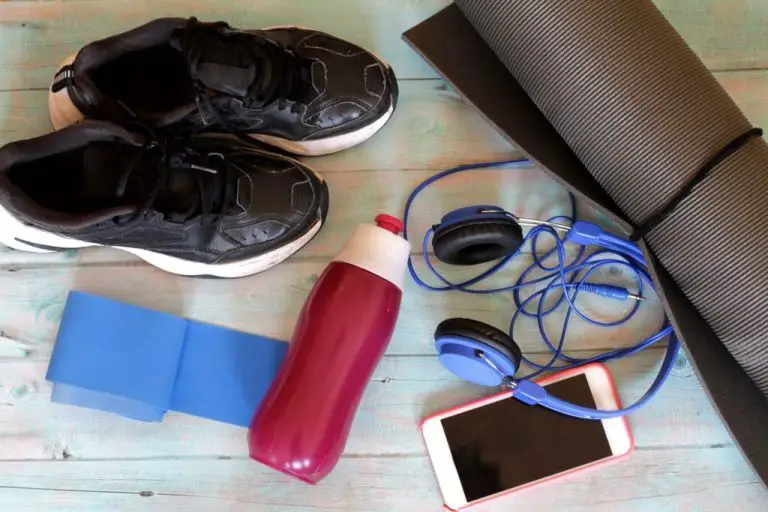How Gym Culture Differs in Various Countries
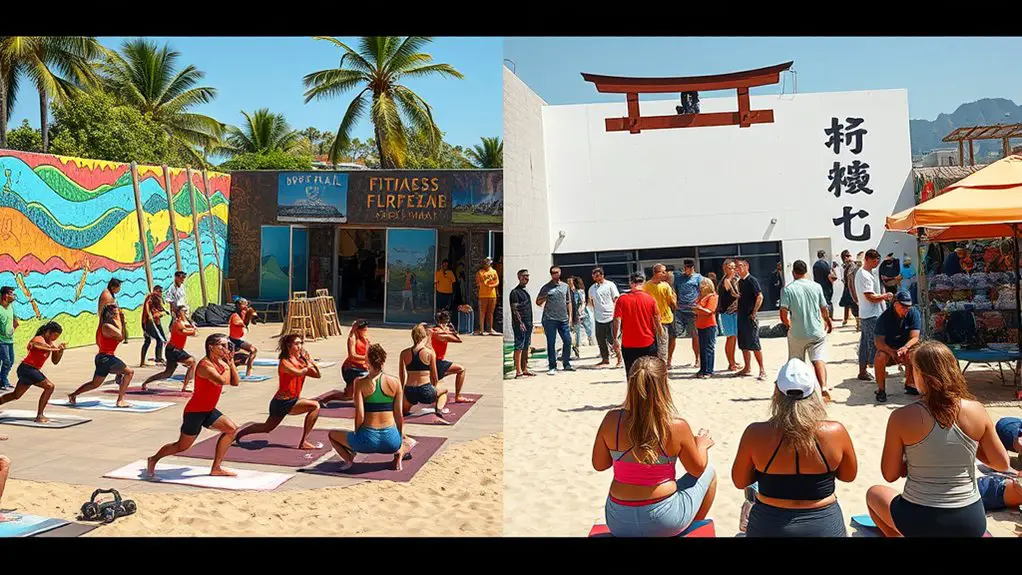
Gym culture varies widely across countries, reflecting unique values and practices. In Brazil, you’ll find communal outdoor workouts fostering social connections, while Japan emphasizes disciplined martial arts. Australia focuses on group classes that build camaraderie, and India values traditional practices like yoga for holistic well-being. Meanwhile, Scandinavia champions functional training, promoting efficiency in fitness. Each culture offers distinct approaches, revealing how environment shapes exercise. Discover more about these fascinating differences and their impacts on fitness experiences.
The Rise of Fitness Influencers in the United States

As the digital landscape evolves, it’s no surprise that fitness influencers have surged in popularity across the United States, shaping not just workout trends but also perceptions of health and wellness. You might notice how these influencers employ fitness marketing tactics that resonate with their followers, blending authenticity with aspirational lifestyles. Unlike traditional advertising, their personal stories create a sense of relatability, making you feel connected to their journeys.
Comparatively, this phenomenon contrasts with fitness cultures in other countries, where community-driven practices often take precedence. In the U.S., influencers curate their brands around individualism, promoting unique fitness routines while fostering a competitive spirit. However, the quest for influencer authenticity often raises questions—are these personas truly representative of everyday fitness challenges? As you engage with their content, consider how these narratives shape your own views on health, fitness, and the broader implications of social media in shaping our wellness journeys.
Communal Workouts and Outdoor Fitness in Brazil
While the U.S. fitness scene often leans on individualistic narratives shaped by influencers, Brazil presents a vibrant contrast with its emphasis on communal workouts and outdoor fitness. Here, you’ll find beach workouts that blend exercise with the lively atmosphere of the coastline, where locals come together to practice yoga or engage in group runs. Samba fitness classes capture the essence of Brazil’s culture, combining rhythm with movement, making workouts feel more like a celebration than a chore.
| Aspect | Brazil | U.S. |
|---|---|---|
| Focus | Community | Individual |
| Environment | Outdoors | Gyms |
| Popular Activity | Samba Fitness | Influencer Workouts |
In Brazil, fitness fosters social connections, creating a sense of belonging. You’ll discover that these communal experiences not only enhance physical health but also enrich cultural ties among participants.
The Emphasis on Martial Arts and Discipline in Japan
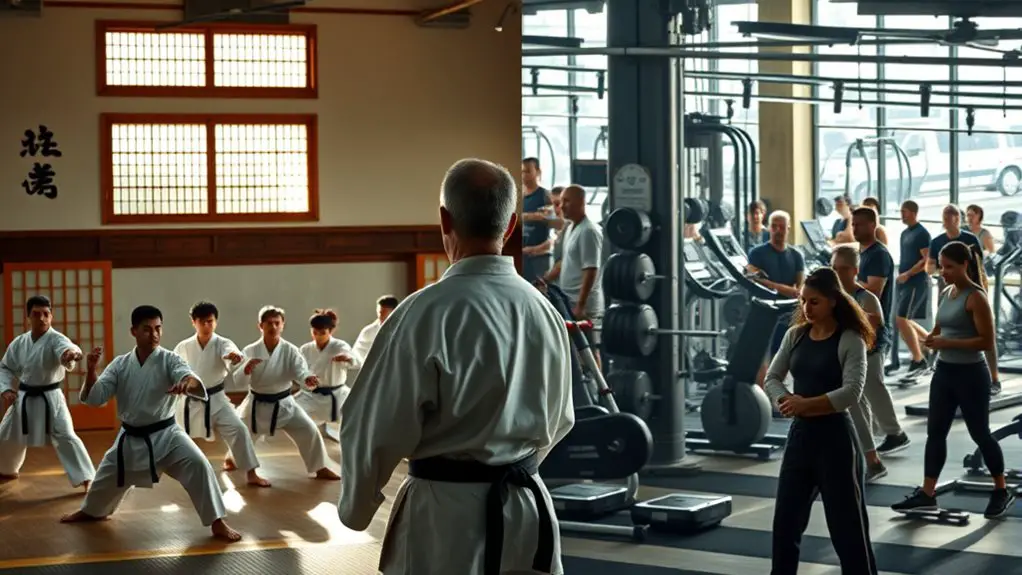
In Japan, the practice of martial arts serves as a profound reflection of cultural values, where discipline and respect are paramount. When you engage in martial arts, you’re not just learning techniques; you’re embracing a way of life that emphasizes personal growth. Here are three key aspects that highlight this cultural significance:
- Discipline Training: The rigorous training routines instill a sense of self-control and perseverance, essential traits in Japanese society.
- Respect for Tradition: Every martial art carries historical significance, fostering a deep respect for heritage and the masters who’ve paved the way.
- Community Connection: Training often occurs in dojos, where camaraderie and mutual support among practitioners create a sense of belonging.
Group Classes and Social Engagement in Australia
Martial arts in Japan emphasize discipline and respect, but in Australia, a different facet of gym culture thrives through group classes and social engagement. Here, you’ll find that group dynamics play a pivotal role in motivating individuals to push their limits. Whether you’re joining a high-energy spin class or a relaxing yoga session, the sense of camaraderie fosters a supportive environment that encourages participation.
A unique aspect of Australian gym culture is the frequent organization of fitness challenges, where you and your classmates can compete in a friendly manner. This not only enhances your physical abilities but also strengthens social bonds among participants. The shared experiences create lasting friendships, making fitness a communal journey rather than an isolated task. In contrast to Japan’s focus on individual discipline, Australia’s group classes highlight the importance of connection, making workouts enjoyable and engaging for everyone involved. Additionally, the incorporation of various techniques in group classes can help participants discover new ways to improve their fitness levels.
Traditional Fitness Practices and Holistic Approaches in India
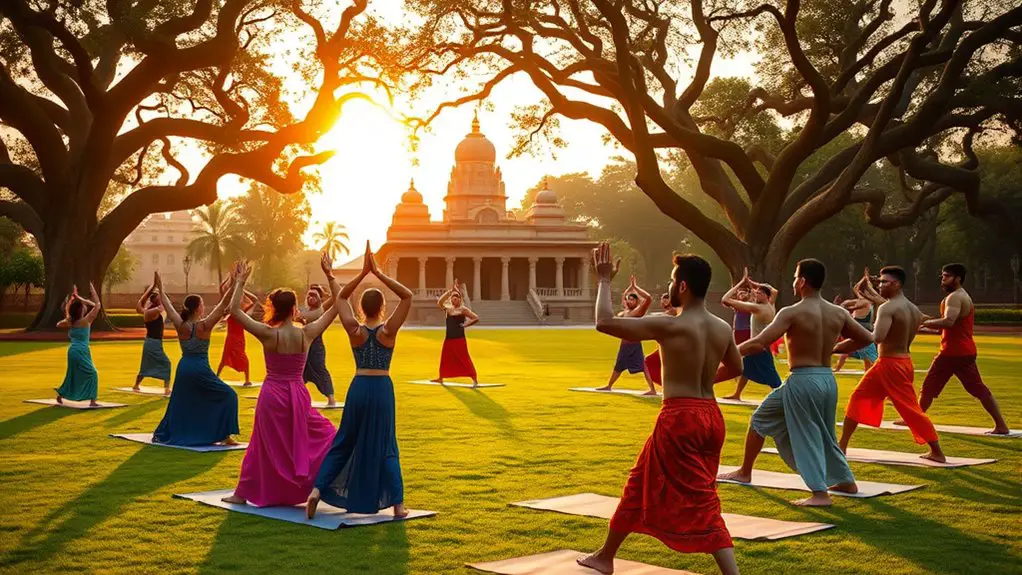
In India, traditional fitness practices like yoga and various martial arts offer a stark contrast to the western gym culture you might be familiar with. These holistic approaches emphasize not just physical strength but also mental clarity and spiritual well-being, creating a thorough fitness experience. By exploring these practices, you’ll uncover how they reflect India’s diverse cultural heritage and values around health.
Yoga and Mindfulness Practices
While many fitness regimens focus solely on physical strength, yoga and mindfulness practices in India offer a holistic approach that intertwines body, mind, and spirit. You’ll find that these practices emphasize overall well-being through various techniques. Here are three core elements:
- Mindfulness Techniques: Practitioners engage in meditation and controlled breathing to foster self-awareness and emotional balance.
- Physical Postures: Asanas not only enhance flexibility and strength but also serve as a gateway to deeper mental focus.
- Yoga Retreats: These immersive experiences allow individuals to disconnect from daily stressors and reconnect with their inner selves.
Traditional Indian Martial Arts
Traditional Indian martial arts offer a unique blend of physical skill and cultural heritage that goes beyond mere combat techniques. When you explore kalaripayattu techniques, you’ll notice they emphasize agility, flexibility, and holistic wellness. This system integrates breath control and mental focus, mirroring the principles found in yoga. In contrast, traditional wrestling, or kushti, highlights strength, endurance, and grappling skills, often practiced in clay pits, emphasizing community and tradition. Both forms reflect India’s diverse cultural landscape, each rooted in historical significance and spiritual growth. Engaging in these practices not only hones your physical abilities but also connects you to India’s rich heritage, offering a profound sense of identity and belonging, unlike typical gym workouts that often focus solely on aesthetics.
The Role of Technology and Innovation in South Korea
As you explore gym culture in South Korea, you’ll quickly notice that technology and innovation play a pivotal role in shaping fitness experiences. South Koreans embrace fitness technology like no other, integrating it into their daily workout routines. Here are some key aspects you’ll find:
- Smart Gym Equipment: Many gyms are equipped with machines that track your performance and offer real-time feedback, making workouts more efficient.
- Virtual Workouts: The popularity of virtual workouts has surged, allowing individuals to participate in classes led by renowned trainers from the comfort of their homes.
- Fitness Apps: South Koreans often use apps to monitor their progress, connect with trainers, and join online communities, fostering a sense of accountability and motivation.
This tech-savvy approach not only enhances personal fitness journeys but also reflects a broader cultural commitment to health and well-being, setting South Korea apart in global fitness trends.
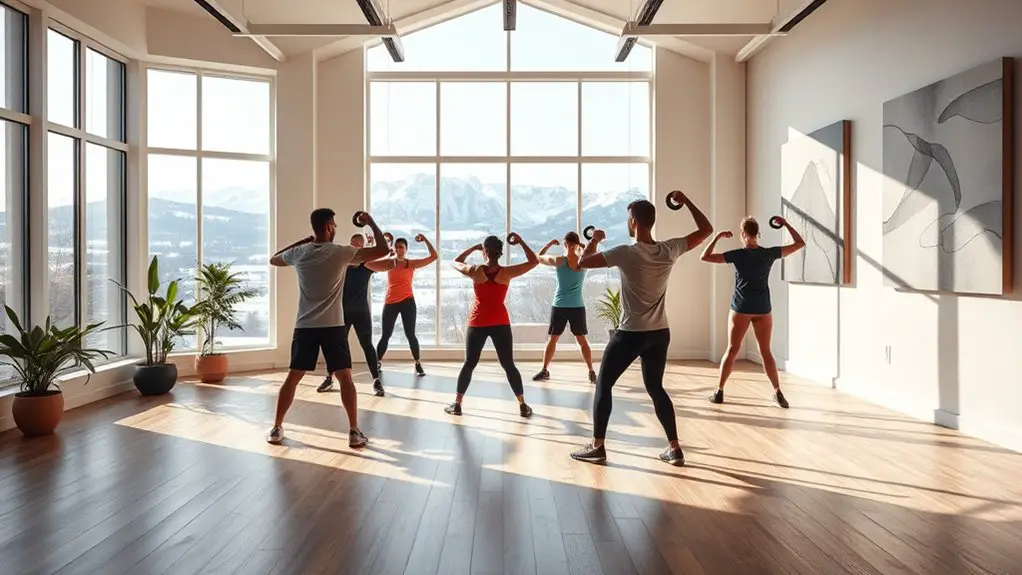
In Scandinavia, where simplicity often meets functionality, minimalist and functional training trends have gained significant traction among fitness enthusiasts. You’ll notice that many gyms focus on equipment-free workouts, encouraging a connection to natural movement. This approach not only highlights the minimalism benefits—like reduced distractions and increased mental clarity—but also promotes a lifestyle that values efficiency and sustainability.
Scandinavian fitness culture often contrasts with the flashy, equipment-heavy environments found in other countries. Here, functional training emphasizes exercises that mimic everyday activities, making it more accessible and relatable. You might find people engaging in group classes that prioritize bodyweight exercises or outdoor circuits, reinforcing community bonds while staying fit.
The Impact of Cultural Festivals on Fitness in Spain
In Spain, traditional celebrations often incorporate movement, turning festivals into opportunities for fitness. You might notice how seasonal events, like local fiestas, encourage active participation, from dancing to sporting competitions. This community engagement not only fosters a sense of belonging but also promotes a unique blend of cultural pride and physical activity.
Traditional Celebrations and Movement
While exploring the vibrant cultural tapestry of Spain, you’ll find that traditional celebrations play a significant role in shaping fitness habits and social interactions. These cultural rituals often merge fitness with festivity, fostering a unique sense of community. Here are three ways traditional celebrations influence movement:
- Dance Festivals: Events like Feria de Abril promote traditional dance, encouraging physical activity while preserving heritage.
- Processions: During Semana Santa, long walks and carrying of statues serve as forms of traditional fitness, connecting spirituality with physical endurance.
- Local Sports: Celebrations often feature traditional sports, such as pelota, allowing participants to engage in competitive fitness while celebrating local culture.
In Spain, fitness isn’t just about the gym; it’s woven into the fabric of communal life through these engaging cultural rituals.
Seasonal Events and Activities
Cultural festivals in Spain not only celebrate heritage but also serve as vibrant platforms for fitness and community engagement. You’ll find that these events often incorporate seasonal sports, encouraging both locals and tourists to participate. For example, during La Tomatina, playful food fights transform into impromptu workouts, while festivals like San Sebastián’s Semana Grande promote festive marathons that attract runners from all over the globe. These marathons not only highlight Spain’s scenic landscapes but also foster a sense of unity among participants. The integration of fitness into these celebrations reflects a cultural appreciation for health and well-being, making fitness an integral part of Spain’s festive atmosphere. Compared to other countries, Spain uniquely intertwines cultural identity with physical activity, creating a lively, inclusive experience.
Community Engagement in Fitness
As you explore the vibrant tapestry of community engagement in fitness during cultural festivals in Spain, it becomes evident that these events serve as a powerful catalyst for promoting physical activity. They intertwine traditional celebrations with innovative fitness initiatives, creating a unique atmosphere. Here are three ways community events enhance fitness culture:
- Group Activities: Festivals often feature communal workouts, dance classes, and sports competitions, encouraging participation across ages.
- Local Partnerships: Local gyms and wellness centers collaborate to host workshops, fostering a sense of belonging and camaraderie among residents.
- Health Awareness: Events highlight nutrition and wellness, educating attendees on maintaining a healthy lifestyle.
Through these engaging experiences, Spain’s cultural festivals not only celebrate heritage but also invigorate community fitness engagement.
Frequently Asked Questions
How Do Gym Memberships Vary in Cost Across Different Countries?
When considering gym membership pricing, you’ll notice regional trends greatly impact costs. In some areas, you’ll find affordable rates, while others may charge premium prices, reflecting local economic conditions and cultural attitudes towards fitness.
What Are Common Fitness Goals Among Gym-Goers in Various Cultures?
When you explore common fitness goals, you’ll find strength training and weight loss often top the list, alongside group classes for community. Many also prioritize mental health, athletic performance, and rehabilitation programs, reflecting diverse cultural values.
How Do Dietary Habits Influence Gym Culture Globally?
When you immerse yourself in dietary habits, you’ll find they’re the roots nourishing gym culture. Dietary preferences and regional cuisines shape nutrition education, influencing meal planning and food trends, making cultural staples essential for fitness journeys.
What Role Does Gender Play in Gym Participation Worldwide?
Gender plays an essential role in gym participation, as societal norms dictate fitness accessibility. You’ll notice how men and women experience different barriers and opportunities, shaping their engagement with physical fitness across diverse cultural landscapes.
How Do Cultural Attitudes Shape Perceptions of Body Image in Fitness?
Cultural attitudes shape your perceptions of body image in fitness, influencing body positivity and fitness ideals. In some cultures, muscularity’s celebrated, while others embrace diverse body types, impacting how you view your own fitness journey.




